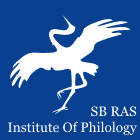 |
|
||||||||||||
|
Institute of Philology of
the Siberian Branch of Russian Academy of Sciences |
|
||||||||||||
|
|||||||||||||
| Sibirskii Filologicheskii Zhurnal (Siberian Journal of Philology) | |
|
Article
Authors: Badma-Khanda B. Tsybikova Institute for Mongolian, Buddhist and Tibetan Studies of the Siberian Branch of the Russian Academy of Sciences, Ulan-Ude, Russian Federation In the section Study of folklore
Abstract: The research investigates two uligers that were originally introduced into scientific circulation by Ts.-A. N. Dugarnimaev. These uligers were recorded from Dugar Manzaron, a talented storyteller representing one of the Buryat ethnic groups living in Mongolia. A brief historical background is provided on the Buryats’ migration to Mongolia. The purpose of the study is to identify common and local connections between the uliger texts analyzed, within the Khori-Buryat epic tradition. The plot, motive structure, and features of the motive fund realization are characterized. Both texts share a central narrative core, which involves the hero’s departure for marriage, battles, and the completion of assigned tasks. Common elements include the return of a kidnapped bride, wife, or parents by a hostile khan or mythical creature. Differences are observed in the elaboration of specific plot motives, such as the location of Mangadhai’s soul, the main character’s metamorphosis, and reincarnation as a relative of Mangadhai. A notable feature of the texts recorded in Mongolia is the incorporation of Buddhist characters, attributes, and rituals into their plots. The analysis of the relationship between plot and motives within the epic narrative is crucial for revealing the artistic space and structure of uliger texts. The plot-compositional organization of the uligers by D. Manzaron is disclosed for the first time, and the consistent nature of the epic tradition across time is identified. These findings provide a valuable comparative framework for analyzing the traditions of other ethnic groups. Keywords: uligers, epic tradition, Buryats of Mongolia, plots, motives, general, distinctive Bibliography: Baldanov S. Zh. Prichiny emigratsii buryat i ikh sovremennoe polozhenie v Mongolii i Kitae [Reasons for emigration of the Buryats and their current situation in Mongolia and China]. In: Diaspory v sovremennom mire: Materialy Mezhdunar. kruglogo stola [Diasporas in the modern world: materials of the international round table: materials of the international round table]. Ulan-Ude, BSU, 2007, pp. 3–8. Burykin A. A. Buddiyskie motivy v fol’klore (na materiale kalmytskikh, tuvinskikh i buryatskikh epicheskikh proizvedeniy i bogatyrskikh skazok) [Buddhist motifs in folklore: the case of Kalmyk, Tuvan and Buryat epics and heroic tales]. The New Research of Tuva. 2020, no. 3, pp. 189–209. Burykin A. A. Individualizatsiya obrazov personazhey kak sredstvo kompozitsii i syuzhetoobrazovaniya v kalmytskom geroicheskom epose “Dzhangar” [Individualization of character images as a means of composition and plot formation in the Kalmyk heroic epic “Dzhangar”]. Studia Culturae. 2002, no. 3, pp. 79–94. Buryatskiy yazyk v regionakh Rossii, Mongolii i Kitaya: sostoyanie, problemy, faktory sokhraneniya i razvitiya [Buryat language in the regions of Russia, Mongolia and China: state, problems, factors of conservation and developmen]. D. D. Badaraev (Ed.). Ulan-Ude, BSU, 2020, 256 p. Cheremisov K. M. Buryatsko-russkiy slovar’ [Buryat-Russian dictionary]. Moscow, Sov. entsikl., 1973, 803 p. Dugarov D. S. Napevy buryatskikh uligerov [“Text Tunes of the Buryat Uligers”]. In: Abay Geser Moguchiy: Buryatskiy geroicheskiy epos [The Mighty Abai Geser: Buryat heroic epic]. Moscow, Vost. lit., 1995, pp. 505–519. Lord A. B. Skazitel’ [The Singer of Tales]. Moscow, Vost. lit., 1994, 368 p. Namzhilova M. N. Khorinskie uligery [The Khorinsky uligers]. Ulan-Ude, BSC SB RAS, 1997, 172 p. Natsagdorzh B. Prichiny migratsii buryat v Mongoliyu: (na primere atsinskikh tsongol-buryat) [The purpose of Buryat migration in Mongolia: an example of atsink’s tsongol-buryats]. Bulletin of BSU. Humanitarian studies of Inner Asia. 2013, no. 1, pp. 61–75. Nimaev D. D. Osnovnye faktory formirovaniya buryatskoy diaspory v Mongolii i osobennosti ee sotsiokul’turnoy adaptatsii [The buryat diaspora in Mongolia: main factors of the formation and the features of its social and economic adaptation]. ESSUTM Bulletin. 2013, no. 1 (40), pp. 179–182. Obraztsy narodnoy slovesnosti mongol’skikh plemen. Teksty [Samples of folk literature of the Mongolian tribes. Texts]. Petrograd, Tip. RAS, 1918, vol. 1: Proizvedeniya narodnoy slovesnosti [Works of folk literature], iss. 3, 648 p. Skrynnikova T. D. Funktsii roda u buryat (konets 19 – 20 vv.) [Functions of the clan among the Buryats (the late 19th – 20th centuries)]. The New Historical Bulletin. 2010, no. 4 (26), pp. 11–18. Ulanov A. I. Buryatskiy geroicheskiy epos [The Buryat heroic epic]. Ulan-Ude, Buryat. kn. izd., 1963, 220 p. Ulanov A. I. K kharakteristike geroicheskogo eposa buryat [On the characteristics of the heroic epic of the Buryats]. Ulan-Ude, Buryat.-Mong. kn. izd., 1957, 172 p. |
 |
Institute of Philology Nikolaeva st., 8, Novosibirsk, 630090, Russian Federation +7-383-330-15-18, ifl@philology.nsc.ru |
© Institute of Philology |


